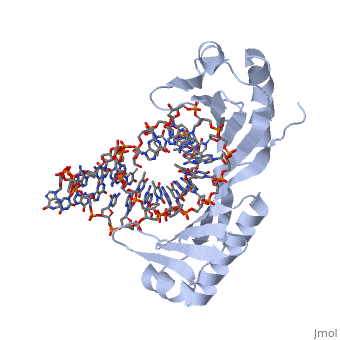Yeast TATA Binding Protein
From Proteopedia
Yeast TATA-Box-Binding Protein/TATA-Box Complex
OverviewThe 2.5 Å crystal structure of a TATA-box complex with yeast TATA-box-binding protein (TBP) is shown at the right (1ytb is a two chain structure with sequence from Saccharomyces cerevisiae that is bound to the TATA-box complex of DNA). [1] A key initial step in TATA-box promoters is the recognition by TBP of the TATA box. [2] TBP initiates strand separation on binding to DNA. [2] As a key factor in the transcription preinitiation complex, TBP helps situate the RNA polymerase II over a gene’s transcription start site. [2] StructureIts characteristic saddle-shape consists of two similar domains. The saddle-shape of TBP provides docking sites that allow other transcription factors and proteins to bind. [2] TBP and numerous TBP-associated factors interact to make TFIID, a transcription factor that is part of the active RNA polymerase II transcription complex. [2] TBP is a 30-kd component of the 700-kd TFIID complex. [2] TBP-DNA interactions contain many important structural features. One important feature of the TBP is that its long dimension follows the trajectory of the minor groove of the DNA. [3] TBP interacts with the DNA through the concave side of the β-sheet. [1] Conserved between the two subdomains are two rows of basic residues that lie along the edges of the protein in proximity to the phosphates in DNA. [3] Down the middle of the groove between the two rows of basic residues lies a band of hydrophobic residues runs down the center of the DNA-binding surface. [3] Mechanism for Binding to DNAThe concave surface of TBP is the site where eight base pairs of the TATA box of DNA binds. [1] On binding, it induces large conformation changes in the bound DNA where it bends the major groove of DNA with unprecedented severity and causes the double helix to become significantly underwound. [1] The purpose of the conformation changes is to widen the double helix’s minor groove, which allows the DNA to render extensive contact with the antiparallel β strands that are located on the concave side of the TBP. [2] The main types of interactions at this interface are hydrophobic interactions between the minor groove and the entire hydrophobic under-surface of the TBP saddle [2] At the binding site, four Phenylalanine residues intercalate themselves between the TATA box base pairs on the DNA. [2] The resulting severe bend and positive writhe alters the trajectory of the flanking B-form DNA. [1] The Lys 133, 145, 151 are involved in the function of recruiting TFIIA. [4] Role as Transcription Factor SubunitTBP acts as a 30-kd subunit of the 700-kd eukaryotic transcription factor TFIID. [2] TBP and a variety of TBP-associated factors, make up the TFIID, which in turn makes up part of the RNA polymerase II preinitiation complex. [2] During the formation of the preinitiation transcription complex of RNA polymerase II, TFIID is the first protein to bind to DNA. [2] The recruitment of other factors required for RNA Polymerase II to initiate transcription results from the binding of TFIID to the TATA box in the promoter region of the gene. [2] The surface of the TBP saddle provides docking sites for the binding of other transcription factors. [2] TFIIA is recruited and interacts primarily with the TBP. [2] TFIIB and TFIIF are recruited and are followed by the RNA polymerase II, TFIIE, and TFIIH. This results in the formation of the basal transcription apparatus. [2]
|
| |||||||||||
Reference
- ↑ 1.0 1.1 1.2 1.3 1.4 Kim Y, Geiger JH, Hahn S, Sigler PB. Crystal structure of a yeast TBP/TATA-box complex. Nature. 1993 Oct 7;365(6446):512-20. PMID:8413604 doi:http://dx.doi.org/10.1038/365512a0
- ↑ 2.00 2.01 2.02 2.03 2.04 2.05 2.06 2.07 2.08 2.09 2.10 2.11 2.12 2.13 2.14 2.15 Berg JM, Tymoczko JL, and Stryer L. Biochemistry. 6th ed. Basingstoke: W.H. Freeman & Co, 2006. 836-37. Print.
- ↑ 3.0 3.1 3.2 Chasman DI, Flaherty KM, Sharp PA, Kornberg RD. Crystal structure of yeast TATA-binding protein and model for interaction with DNA. Proc Natl Acad Sci U S A. 1993 Sep 1;90(17):8174-8. PMID:8367480
- ↑ Kim TK, Zhao Y, Ge H, Bernstein R, Roeder RG. TATA-binding protein residues implicated in a functional interplay between negative cofactor NC2 (Dr1) and general factors TFIIA and TFIIB. J Biol Chem. 1995 May 5;270(18):10976-81. PMID:7738039

